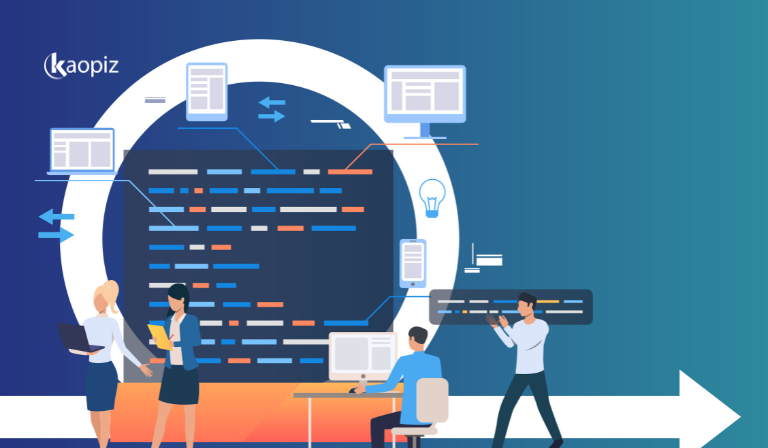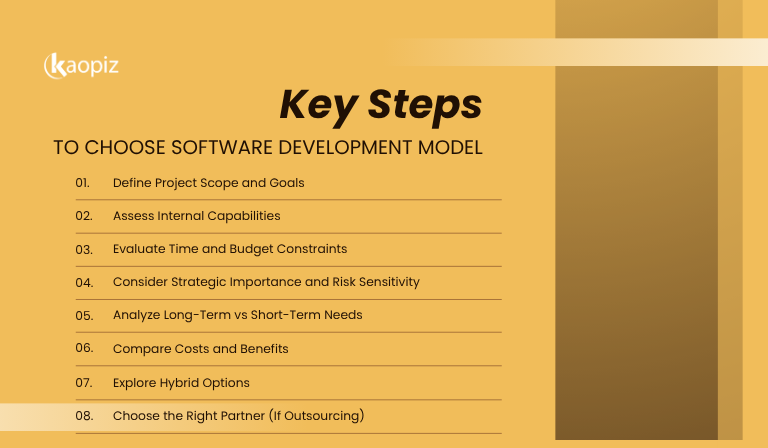In-House vs Outsourcing Software Development: Which Is Right for You?
Software development plays a critical role in driving innovation, operational efficiency, and customer satisfaction. As businesses across industries race to build scalable, high-performing applications, one key question continues to arise: Should you develop software in-house or outsource it to an external partner?
In this blog, we break down the key differences between in-house vs outsourcing development, explore the benefits and drawbacks of each, and provide key steps to help you make the right choice for your next IT project. Let’s dive in!
Table of Contents
- What Is In-House Software Development?
- What Is Outsourcing Software Development?
- In-House vs Outsourcing: Key Differences
- Pros and Cons of In-House vs Outsourcing
- When to Choose In-House vs Outsourcing
- Steps to Choose the Right Software Development Model
- How Kaopiz Supports Your IT Outsourcing Needs
- Conclusion
- FAQs
What Is In-House Software Development?
In-house software development refers to the process of building and managing software solutions using your company’s internal team. This means hiring full-time developers, designers, QA engineers, project managers, and other technical staff who work directly under your organization, often within the same office or operational framework.

With in-house development, your team has complete control over the project from start to finish. This includes defining the roadmap, aligning the product vision with business goals, customizing workflows, and maintaining close collaboration between developers and stakeholders.
What Is Outsourcing Software Development?
Outsourcing software development involves delegating your software project or specific development tasks to an external third-party vendor, agency, or dedicated team. These outsourced partners can be located in the same country (onshore), nearby regions (nearshore), or entirely different countries (offshore)—each with its own advantages in terms of cost, talent pool, and time zone alignment.
Instead of building and managing a full in-house team, companies that outsource software development tap into external expertise to accelerate delivery, reduce operational costs, and gain access to specialized skills.
In-House vs Outsourcing: Key Differences
Choosing between in-house vs outsourcing software development involves more than just budget—it’s about how quickly you can scale, the level of control you need, and the type of expertise your project requires.
Below is a side-by-side comparison of the key factors to help you evaluate in-house vs outsource:
| Factor | In-House Development | Outsourcing Development |
|---|---|---|
| Cost | Higher upfront and long-term costs (salaries, infrastructure, benefits) | Lower overall cost with flexible pricing (e.g., hourly, project-based) |
| Speed to Market | Slower startup due to hiring and onboarding | Faster kickoff with ready-to-deploy expert teams |
| Talent Access | Limited to local market; hiring takes time | Access to global talent pool and niche expertise |
| Control & Communication | Direct management and real-time collaboration | Less direct control; requires clear communication channels |
| Scalability & Flexibility | Scaling up/down is slow and costly | Easy to scale resources up or down based on demand |
| Data Security/IP Protection | Higher control over internal data handling | Depends on vendor; requires contracts and security compliance (e.g., ISO) |
Cost
Cost is often the most significant factor when comparing in-house software development vs. outsourcing, and for good reason. Building an internal team involves substantial upfront and ongoing expenses that go far beyond just salaries. These include recruitment fees, employee benefits, office space, equipment, training, and long-term commitments like payroll and taxes.
In contrast, outsourcing software development is typically more cost-efficient, especially for short- to mid-term projects. Companies can avoid the overhead associated with full-time hires by paying only for the services they need, whether on a fixed-price, hourly, or dedicated team basis.
Speed to Market
This is a crucial factor when comparing in-house vs outsourcing IT as it helps businesses to gain a competitive edge, especially in fast-moving industries like fintech, e-commerce, or health tech.
While in-house teams offer close collaboration and better internal alignment, ramping up an internal development team takes time. Recruiting skilled developers, onboarding them, and building a fully functional team structure can delay project kick-off by weeks or even months. Additionally, internal teams may be tied up with other tasks, reducing their ability to focus solely on new initiatives.
Outsourcing significantly accelerates time to market by giving companies immediate access to ready-to-go, experienced teams. With a trusted IT outsourcing vendor, businesses can skip the hiring phase and begin development almost immediately. Outsourced teams often follow agile methodologies and bring established workflows that speed up delivery.
Talent Access
Access to skilled talent is one of the biggest challenges—and differentiators—when choosing between in-house vs outsourcing software development.

Hiring in-house gives you full control over team selection, skillsets, and cultural fit. This is ideal for companies that need deep domain knowledge or long-term commitment to a product. However, finding and retaining top tech talent is increasingly difficult, especially in competitive markets like the U.S., Japan, or Singapore. The hiring process is time-consuming, and niche skills (such as AI, blockchain, or DevOps) can be scarce or expensive to secure locally.
Outsourcing opens the door to a global talent pool, giving businesses immediate access to a wide range of specialized skills and technologies. Need to hire dedicated developers, a cloud DevOps engineer, or a computer vision expert? Outsourcing partners often have them ready.
Control and Communication
Developing software in-house means your team works side by side—often in the same time zone, or even the same office—making it easier to stay aligned and communicate in real time. It’s a setup that naturally supports quick feedback loops and tighter collaboration. But that doesn’t mean it’s without issues. Internal teams can still face miscommunication, especially when departments work in silos or team members juggle multiple projects.
On the other hand, working with external teams—especially those in different countries or time zones—adds another layer of complexity. If expectations, timelines, or communication channels aren’t clearly established from the beginning, things can quickly get out of sync.
That said, experienced outsourcing partners use structured communication tools, agile methodologies, and dedicated points of contact (e.g., BrSEs, project managers) to bridge the gap and maintain strong collaboration. Regular meetings, clear documentation, and aligned processes are key to ensuring success.
Scalability and Flexibility
As business needs evolve, the ability to scale your development team quickly and adapt to changing project requirements is essential for long-term success.

In-house teams offer consistency and deep product knowledge, but scaling them is often slow and costly. Hiring new developers takes time, and your ability to scale is limited by recruitment capacity, budget, and available office infrastructure. If demand suddenly drops, you’re also left with the burden of managing excess resources.
Outsourcing provides greater flexibility and rapid scalability, making it ideal for projects with fluctuating workloads or tight deadlines. Imagine your startup just landed a big client, but you only have 3 developers. Can you scale to 10 in a month? Probably not without serious hiring delays. That’s where a trusted outsourcing partner shines.
Data Security/IP Protection
When it comes to software development, protecting sensitive data and intellectual property (IP) is a top priority. The choice between in-house vs outsourcing can significantly impact how security is managed.
In-house teams offer greater control over data access and IP management. Since all development is done internally, it’s easier to enforce company-wide security policies, monitor employee activity, and limit access to confidential assets. This setup is ideal for projects involving proprietary algorithms, user data, or regulatory compliance (e.g., GDPR, HIPAA).
While outsourcing can unlock speed and global talent, it also means trusting an external partner with your data. That’s why choosing a vendor with strong security protocols isn’t just a checkbox—it’s an essential peace of mind. Data may be shared across borders, and control over development environments is reduced. That’s why it’s critical to choose a trusted partner with proven security measures and certifications (e.g., ISO 27001, NDAs, IP protection clauses).
Pros and Cons of In-House vs Outsourcing
In-house development vs outsourcing approaches offer unique advantages and drawbacks depending on your business goals, budget, and technical requirements. Let’s explore the key in-house vs outsourcing pros and cons to help you make a more informed decision.
In-House Software Development: Pros & Cons
Building software in-house gives businesses full control over the development process and closer alignment with internal goals. However, it also comes with higher costs and resource constraints.
| Pros | Cons |
|---|---|
| Full control over project direction and internal team management | High costs for recruitment, salaries, and infrastructure |
| Strong alignment with company culture and long-term goals | Slower time-to-market due to hiring and onboarding delays |
| Real-time communication and faster internal collaboration | Limited access to niche or emerging tech skills |
| Better internal knowledge retention and process ownership | Challenging to scale quickly for large or urgent initiatives |
Outsourcing Software Development: Pros & Cons
Outsourcing is a popular strategy for companies looking to reduce costs, speed up delivery, and access specialized talent. It also comes with challenges that need careful management, especially around communication and control.
| Pros | Cons |
|---|---|
| Lower development costs and reduced overhead | Less direct control over daily operations and decision-making |
| Faster time-to-market with ready-to-deploy teams | Potential communication challenges across time zones and cultures |
| Access to global talent and specialized skill sets | Data security and IP protection require clear contracts and compliance |
| Flexible scaling based on project needs | Quality may vary between vendors; requires careful partner selection |
When to Choose In-House vs Outsourcing
Deciding between in-house vs outsourcing depends on your business priorities, project complexity, available resources, and long-term goals. The in-house and outsource approach serves different needs, and the right choice often comes down to what you value most—control, speed, cost-efficiency, or flexibility.
Choose in-house development when:
Choose outsourcing when:
Looking at in-house vs outsourcing examples across industries can help clarify which model suits your project best. For many companies, the best approach is hybrid, keeping core product ownership in-house while outsourcing specific tasks or modules to external partners for greater agility and cost control.
Steps to Choose the Right Software Development Model
Making the right choice starts with a structured decision-making process. Follow these steps to evaluate whether outsourcing vs in-house development is the best fit for your project:

How Kaopiz Supports Your IT Outsourcing Needs
At Kaopiz, we help businesses around the world accelerate their software development by providing reliable, scalable, and cost-effective IT outsourcing services. Whether you need to build a full-scale product or extend your existing team, our services are designed to adapt to your unique needs.

With 500+ successful projects delivered to 150+ global clients, we bring deep expertise in web and mobile app development, AI and machine learning, cloud migration services, DevOps, and QA/testing services. As an ISO 27001-certified company and an AWS Advanced Tier Services Partner, we meet the highest standards of quality, security, and compliance.
Our engagement models are flexible—from dedicated development teams to project-based delivery or staff augmentation—allowing you to scale quickly without the overhead of in-house hiring. Our developers are highly skilled, fluent in English, and experienced in agile methodologies, ensuring fast onboarding and smooth collaboration.
Kaopiz acts not just as a vendor but as a trusted technology partner. We work closely with your internal teams to ensure alignment, transparency, and results. Whether you’re launching a new digital product, modernizing legacy systems, or expanding your tech capabilities, we’re here to support you every step of the way.
Conclusion
Deciding between in-house vs outsourcing is a strategic choice that depends on your goals, resources, timeline, and project complexity. In-house teams offer greater control and cultural alignment, while outsourcing provides speed, scalability, and access to global talent. Each model has its strengths, and in many cases, a hybrid approach offers the best of both worlds.
The key is to evaluate your needs carefully, consider the long-term impact, and choose a solution that supports your business growth. If you’re exploring outsourcing as a way to move faster, reduce costs, or tap into specialized expertise, Kaopiz is here to help. With a proven track record and flexible engagement models, we’re ready to be your trusted development partner.
FAQs
Which Countries Are Popular for IT Outsourcing?
Popular destinations for IT outsourcing include India, Vietnam, the Philippines, Poland, and Ukraine. These countries are known for their large talent pools, competitive pricing, and strong technical expertise.
Vietnam, in particular, is gaining global attention for its top IT outsourcing companies, high-quality development teams, cultural compatibility, and cost-efficiency, making it a preferred choice for clients across Japan, Singapore, the US, and Europe.
What Types of IT Services Are Commonly Outsourced?
Businesses frequently outsource IT services such as:
These services help companies scale efficiently, access specialized skills, and accelerate digital transformation.
How Do I Choose the Right Outsourcing Partner?
Start by evaluating the vendor’s technical expertise, project portfolio, and industry experience. Check for certifications (like ISO 27001), communication practices, scalability, and client references. A reliable outsourcing partner should offer transparency, flexible engagement models, and a proven ability to align with your business goals. Look for long-term value, not just short-term cost savings.




















